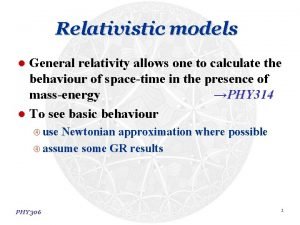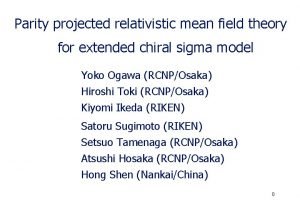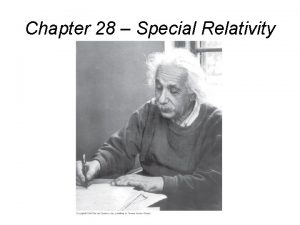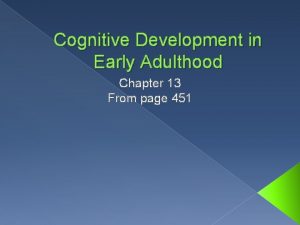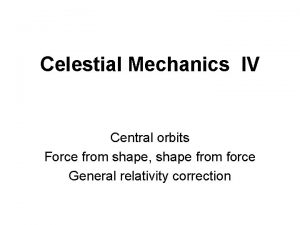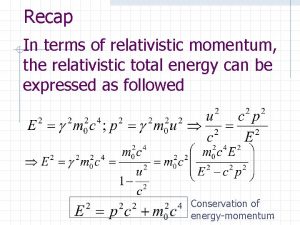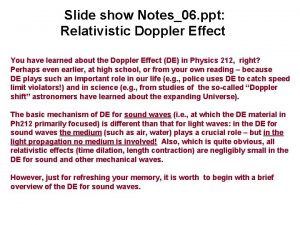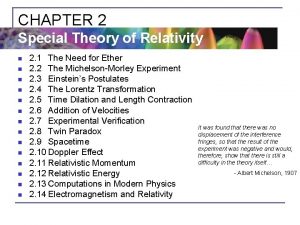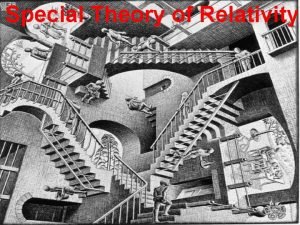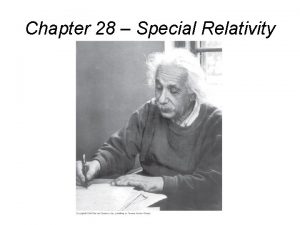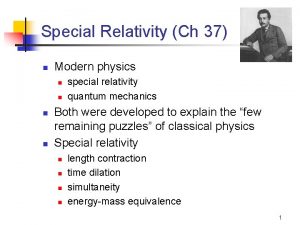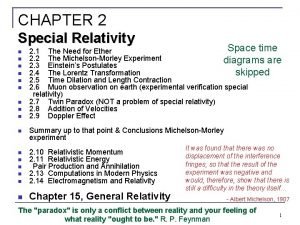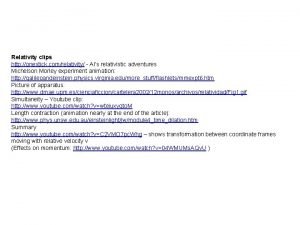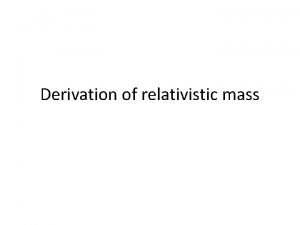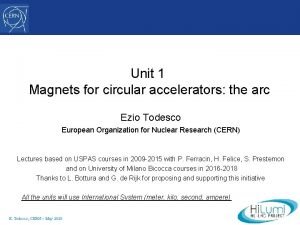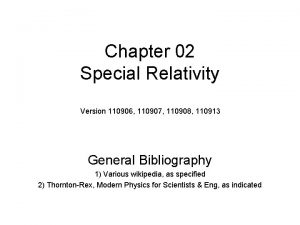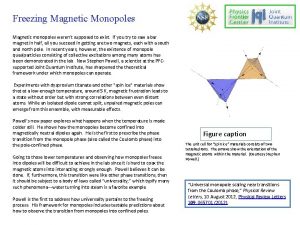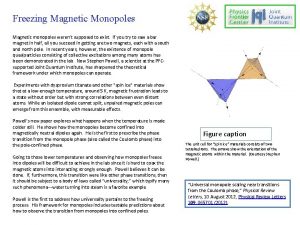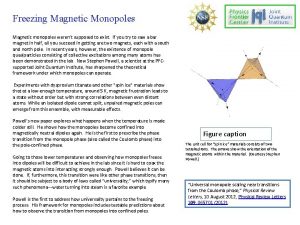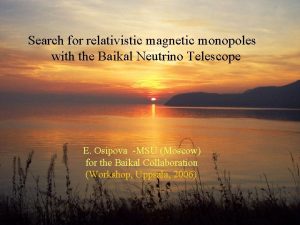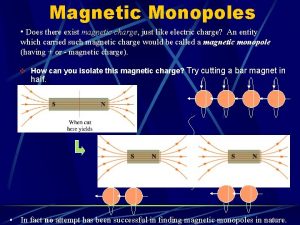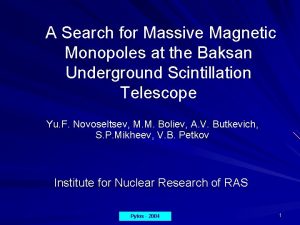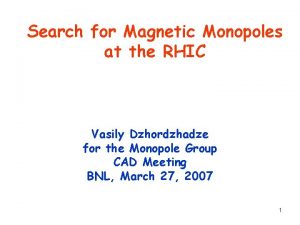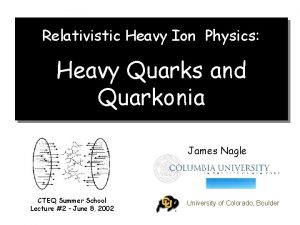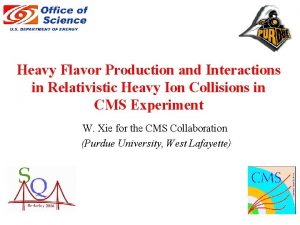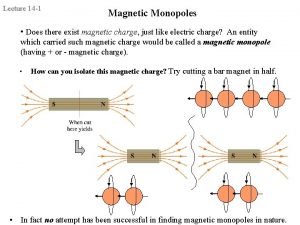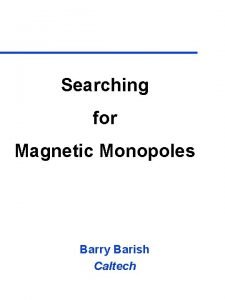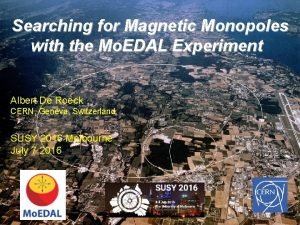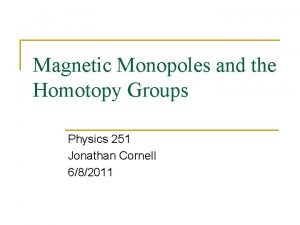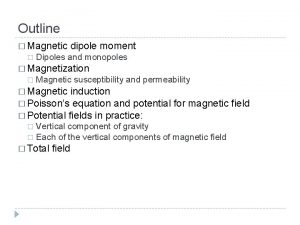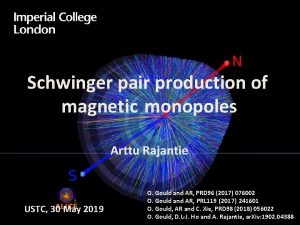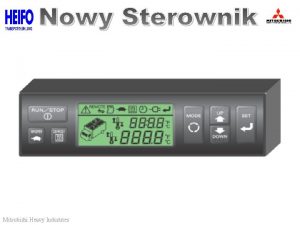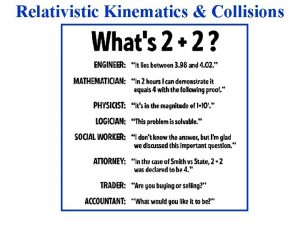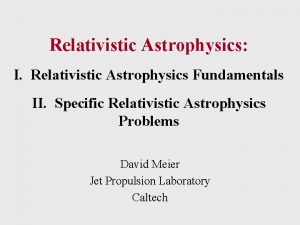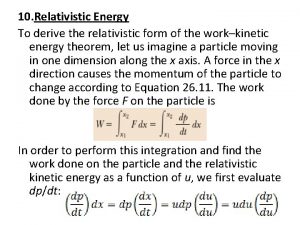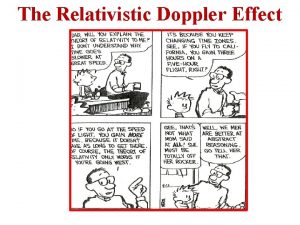Search for Magnetic Monopoles at the Relativistic Heavy



































- Slides: 35

Search for Magnetic Monopoles at the Relativistic Heavy Ion Collider (RHIC) Praveen Chaudhari *, Vasily Dzhordzhadze, Veljko Radeka, Margareta Rehak, Pavel Rehak, Sergio Rescia, Yannis Semertzidis, John Sondericker, and Peter Thieberger BNL PAC Meeting September 12, 2006 * Spokesperson 1

Outline • • Motivation Experimental Approach Monopole Detector Interaction with SQUIDs and Walls DAQ and Trigger • • • Influence on STAR and PHENIX Future Developments Schedule and Costs 2

Motivation • Maxwell equations (1873) Magnetic monopole terms Introducing magnetic monopole makes equations symmetric • GUT (1974) requires monopoles 3

Motivation (continued) Dirac showed (1931) g = nħc/2 e = (137/2) ne, n=1, 2, 3, … • First strong scientific motivation to search for magnetic monopoles • The defining property of a monopole 4

Motivation (continued) • Two types of monopole searches: GUT and accelerator based • GUT mass ~1016 Ge. V - 10 Te. V • No evidence of GUT monopoles at the level of Parker Limit (~10 -15 cm-2 sr-1 s-1) • No evidence in accelerator based search: Bradner and Isbell(1959) 2006 • BNL experiment at AGS: Purcell et al. (1963) 5

Monopole Detectors • Previous accelerator searches assumed mass, velocity, charge, or binding energy to nuclei: etch tracks, scintillators, ionization detectors, or capture in liquids and solids • We propose to detect a monopole via its magnetic charge use an inductive detector. Use superconducting coils and SQUID technology 6

Monopole Detector Setup Superconducting Shield LHe Dewar Vacuum Valve Superconducting Grid RHIC Beam tube Silicon Detectors Trapezoidal Transition piece Gradiometers IR Baffle Biased Screen Heat Station Heat Shield Mu Metal Shield 2 m 7

Monopole Detector Elements Superconducting Shield Vacuum Valve RHIC Beam Tube Silicon Detectors Gradiometers IR Baffle Biased Screen Heat Station Trapezoidal Transition Piece 8

Gradiometer Assembly 4 K Cooling Ring Solder Tab Support Ring SQUID Silicon Gradiometer Coil 9

Gradiometer • Rejects “stray” B fields but has full sensitivity to monopole signal • Built with superconductor on Si substrate (for cooling) • Built in quadrants to reduce inductance and fit into 30 cm diameter commercial Si wafers 10

Third Order Gradiometer • 3 rd or 4 th order gradiometer coils are being investigated • L 3 rd~2 m. H • L 4 th~3 m. H • 3 rd order gradiometer cancels polynomial terms up to 25 th degree to better than 1% • 4 th order gradiometer cancels polynomial terms up to 75 th degree to better than 1% 11 150 mm

Fourth Order Gradiometer Cancellation 12

SQUID Noise • Time resolution ~1 ms • ~100 ms measurement time needed to achieve 0. 1 f 0 sensitivity 0. 2 0. 1 Flux Noise f 0 0. 15 0. 07 0. 05 0. 03 20 50 100 200 Measurement time (ms) 500 1000 13

Geometry of Silicon Detectors 14

Interaction of Charged Particles with SQUIDs and Chamber Wall • Central Au-Au collisions: at the location of SQUIDs less than 120 charged particles/sr. For a 10 μm. X 10 μm SQUID Josephson junction probability of a single incidence of ~ 10 -10, and of coincident events of ~10 -20 • Estimated secondary radiation from stainless cylinder walls is also negligible 15

DAQ and Trigger • Two types of trigger: monopole candidates and monitoring • Monopole candidates: coincident signals from gradiometer and/or Silicon detectors • Monitoring triggers: monitored detector clocked to RHIC • Use RHIC luminosity monitors to obtain integrated luminosity 16

Influence on STAR and PHENIX • Common vacuum with RHIC due to 35 cm. X 5 cm cut in the RHIC tube • Provide electrical continuity by placing a grid across cut • Mitigate possible but very unlikely vacuum disturbance to RHIC by placing a valve at the entrance to the monopole chamber • Two additional vacuum valves on RHIC beam tube 17

Future Developments • Observe credible monopole signal. Determine the mass of the monopole by carrying out a g/m experiment • No credible signal but SQUID detectors perform satisfactorily, as demonstrated by a clear signal from magnetic pseudopole • Approach LHC and/or ILC 18

Schedule 19

Cost Materials and supplies: 1. Detector cryostat and refrigeration system 2. Magnetic detection system (gradiometers, SQUIDS, control and signal processing electronics) 3. Silicon detector system 4. Data Acquisition (DAQ) Subtotal: $330 k $190 k $220 k $80 k ===== $820 k + ($287 k+ C-AD) Manpower: 1. S&P 2. 5 FTE $650 k 2. Other (designer and tech. specialists) 2 FTE $360 k Subtotal: $1, 010 k ==== Project total: $1, 830 k + ($287 k +C-AD) 20

Summary • The counterpart to the quantized elementary charge is the magnetic monopole. No monopole has been detected so far • Our proposed search is to measure the magnetic charge of a monopole • Detector can be used in future higher energy accelerators: LHC and/or ILC 21

Back-up Slides 22

Charged Particle Distribution 23

Secondary e Yield Angular Dependence 24

Secondary Electron Yield 25

Thermal Analysis of the SQ Grid 26

Second and Fourth order Gradiometer 27

Deformation and Stress of the Gradiometer 28

Vibration and Deformation of the Gradiometer 29

Second and Third Mode Vibration 30

First mode Supporting and Harmonic Excitation 31

First mode Supporting and Harmonic Vibration 32

¼ of Shield 33

Shield with and without Hole 34

Increased acceptance Set-up 35
 Maxwell's equations magnetic monopoles
Maxwell's equations magnetic monopoles Shratey calculator
Shratey calculator Wb magnetic flux
Wb magnetic flux Magnetic moment and magnetic field relation
Magnetic moment and magnetic field relation F=i(lxb)
F=i(lxb) Magnetic retentivity
Magnetic retentivity General relativity formula
General relativity formula Relativistic mean field theory
Relativistic mean field theory Relativistic kinetic energy
Relativistic kinetic energy Labouvie-vief pragmatic thought
Labouvie-vief pragmatic thought Relativistic thinking example
Relativistic thinking example Site:slidetodoc.com
Site:slidetodoc.com Relativistic momentum
Relativistic momentum Doppler effect ppt
Doppler effect ppt Relativistic velocity
Relativistic velocity Length contraction
Length contraction A physical education chapter 28
A physical education chapter 28 Relativistic thinking example
Relativistic thinking example Relativistic momentum
Relativistic momentum Kinetic energy of a relativistic particle
Kinetic energy of a relativistic particle Bertrand postulate
Bertrand postulate Early adulthood cognitive development
Early adulthood cognitive development Relativistic mass formula
Relativistic mass formula Relativistic circular motion
Relativistic circular motion Relative speed of approach
Relative speed of approach Lek med geometriska former
Lek med geometriska former Claes martinsson
Claes martinsson Tillitsbaserad ledning
Tillitsbaserad ledning Nyckelkompetenser för livslångt lärande
Nyckelkompetenser för livslångt lärande Rim dikter
Rim dikter Tidbok yrkesförare
Tidbok yrkesförare Modell för handledningsprocess
Modell för handledningsprocess Shingelfrisyren
Shingelfrisyren Vilken grundregel finns det för tronföljden i sverige?
Vilken grundregel finns det för tronföljden i sverige? Verktyg för automatisering av utbetalningar
Verktyg för automatisering av utbetalningar Big brother rösta
Big brother rösta






